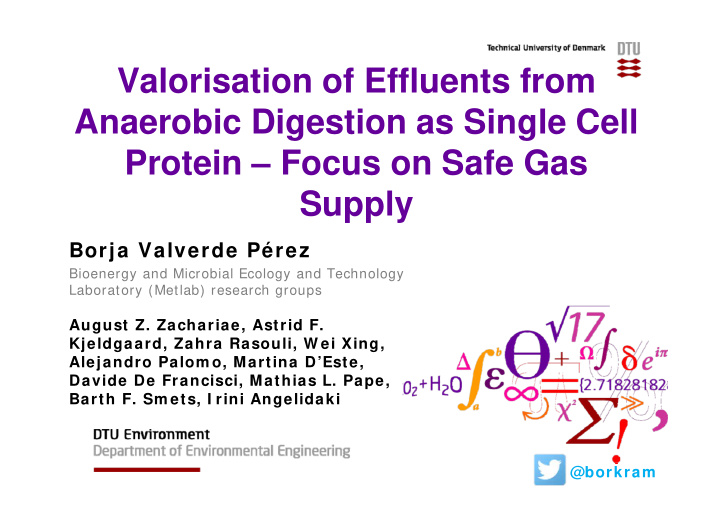



Valorisation of Effluents from Anaerobic Digestion as Single Cell Protein – Focus on Safe Gas Supply Borja Valverde Pérez Bioenergy and Microbial Ecology and Technology Laboratory (Metlab) research groups August Z. Zachariae, Astrid F. Kjeldgaard, Zahra Rasouli, W ei Xing, Alejandro Palom o, Martina D’Este, Davide De Francisci, Mathias L. Pape, Barth F. Sm ets, I rini Angelidaki @borkram
Agenda Microbial protein and its impact on nitrogen cycle Co-cultivation of green microalgae and methanotrophic bacteria Bubble-free membrane bioreactor 2
Microbial protein and Methane Oxidizing Bacteria ( MOB) W hat is m icrobial protein? : protein produced by microbes, which can be used as feed ingredient (EU approved!) W hy MOB? : Bacteria have high growth rates and crude protein content compared to algae and fungi. Compared to algae, the cultivation of MOB’s is less space demanding. 1 st generation process already exists: natural gas and synthetic nitrogen resources [ http: / / www.unibio.dk ] Methane can be produced from most organic waste at a relatively low cost.
Anthropogenic nitrogen cycle Atm osphere GHG’s Consequences include: GHG’s Manure N 2 N 2 N 2 GHG’s NH 3 GHG’s • Clim ate change • Eutrophication and other chem ical pollution of aquatic Livestock ecosystem s Anim al Synthetic Acid Land-use change deforestation and other habitat products • N-Fertilizer ~ 145 Mt/ y losses WWTP Haber-Bosch Croplands • Natural resources depletion N-fixation Leaching/ run-off of reactive N > 1 % of global Consumers energy Surface and consumption ground water
Closing the nitrogen drain SCP production Manure Atm osphere SCP GHG’s GHG’s N 2 N 2 N 2 GHG’s NH 3 GHG’s Livestock Anim al Synthetic products N-Fertilizer WWTP Haber-Bosch Croplands NH 3 N-fixation Leaching/ run-off of reactive N CH 4 Consumers SCP Surface and ground water SCP production
6 Nutrient Managem ent – Traditional Biogas – energy Nutrients – fertilizer Manure approach
Nutrient Managem ent – Nutrient Upcycling and Reuse in Agriculture Single Cell Protein Biogas Manure Ferm enter Nutrients Plant Grow th Prom oters 7
Focus on Safe Gas Supply
9 Rasouli et al., 2 0 1 8 ( BEJ ) Co-cultivation of algae and m ethanotrophs
Co-cultivation of algae and m ethanotrophs Blue: CH 4 Red: CO 2 Green: O 2 o The consortium effectively removed organic carbon and nutrients o Imbalance between photosynthesis and methane oxidation o Level of explosion is achieved! o Further optimization is needed 10
Co-cultivation of algae and m ethanotrophs Contains the essential am ino acids for chicken 11
Bubble-free m em brane bioreactor Cultivation of a mixed culture of methane oxidizing bacteria First experiences: • Suboptimal supply of gasses leads to biofilm formation • Leakage of gases and building of headspace • Progressive lose of methanotrophs
Bubble-free m em brane bioreactor Progressive lose of methanotrophs • Methylococcales (pink) • Methylophilales (light green) 13
Bubble-free m em brane bioreactor After gas supply optimization good oxygen to methane ratio • Biomass grows in suspension • Microbial protein content increased potential recovery of methanotrophic biomass • Minimization of gas leakage and avoidance of head space 0,08 After optimization Before optimization 0,07 0,06 g ‐ amino acid/g ‐ DW 0,05 0,04 0,03 0,02 0,01 0 14
Take hom e m essage • Both proposed options can produce biomass suitable as feed ingredient • Co-cultivation of green microalgae and methanotrophs o Challenges • Photosytensis and methane oxidation need to be balanced • Complex process control is needed o Opportunities • Valorization of the carbon dioxide from biogas • Bubble-free membrane bioreactor o Challenges • Risk of carbon dioxide accumulation from biogas and methane oxidation o Opportunities • Operation below the low explosive limit 15
@I riniAngelidaki @Metlab_ DTU Acknow ledgem ent
W hat happens w ith the real pollutants? Who are the bad guys? How do we get read of them? Heavy metals Membrane filtration Impurities Bio-electrochemical systems Pathogens Pharmaceuticals Antibiotic resistance genes NH 3 NH 3 NH 3 NH 3 NH 3 NH 3 NH 3 NH 3 NH 3 NH 3
Recommend
More recommend